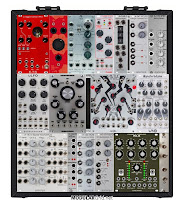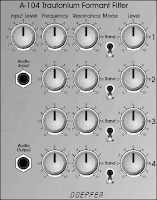Al James' extensive piece in the April 2013
Sound on Sound examines modules by category, giving brief appraisals of the most highly recommended products and listing additional
honourable mentions. Discussed on Muffwiggler
here.
And here's a run-down (I have the ones
in bold):
Oscillators
Tiptop Z3000
Intellijel Dixie II (for size) and Rubicon (for flexibility)
Cyclonix Cyclebox
Makenoise DPO
Harvestman Piston Honda
Livewire AFG
HMs:
Flame Talking Synth; Harvestman Hertz Donut; ASol and ASys; Bubblesound VCOb; Cwejman VCO6; Doepfer; Kilpatrick K3020, Metasonix R55; MFB Triple; Pittsburgh Generator;
Malekko Anti.
Filters
Tiptop Z2040
Intellijel Korgasmotron
Harvestman Formanta Plovoks (worth a look from the description)
Livewire Frequensteiner
Doepfer Wasp
FoH Plague Bearer
HMs: AMSynth range; ASys RS500e; Cwejman range; Bubblesound SEM20; Doepfer range; Harvestman Bionic Lester; Intellijel Dr Octature; Metasonix R52; Pittsburgh; Toppobrillo; Malekko Borg & Boogie; WMD Synchrodyne and Hadron Collider.
Function Generators
MakeNoise Maths
MakeNoise Wogglebug
ADDAC Marble Physics
HMs 4MS PEG; ASys RS510e;
Bubblesound uLFO; Circuit Abbey ADSRjr; Flame C3 Knob Recorder; Harvestman Double ANdore; Intellijel Quadra and Planar; MFB Dual LFO; Pittsburgh ADSR; Synthesis Tech E355 Morphing Dual LFO; Malekko Envelator and
NoiseRing.
Sequencers, Clock Dividers & Pitch Quantisation
Tiptop Z8000 Matrix Sequencer
MakeNoise
Pressure Points and René
4MS RCD and SCM
Intellijel uScale
HMs
Pitch - ADDAC 207; Flame Tame Machine and Chord Machine; Doepfer A156; Toppobrillo Quantimator

Sequence - Modcan Touch; Intellijel Metropolis and uStep; Doepfer A155
Clock - Flame Clockwork;
Doepfer A160; 4MS PEG
Mixers, Low-pass Gates, Utilities & Logic
MakeNoise Optomix and ModDemix
Intellijel Mutamix
HMs Doepfer range; Fonitronik MH01; Intellijel Unity Mixer; Manhatten Mix; STG .Mix; Synovatron CV Tools.
Effects
Tiptop Z5000 and ZDSP
Harvestman Malgorithm and Tyme Sefari
MakeNoise Echophon and
Phonogene
Intellijel uFold
Toppobrillo Triple Wavefolder
Doepfer
Spring Reverb
ASol SR01
HMs: Flame FX6; Doepfer BBDs; Pittsburgh Delay; FoH Sound of Shadows; Snazzy FX Ardcore; Synthesis Tech Deflector Shield;
WMD Geiger Counter
The second image is the author's current setup.












































